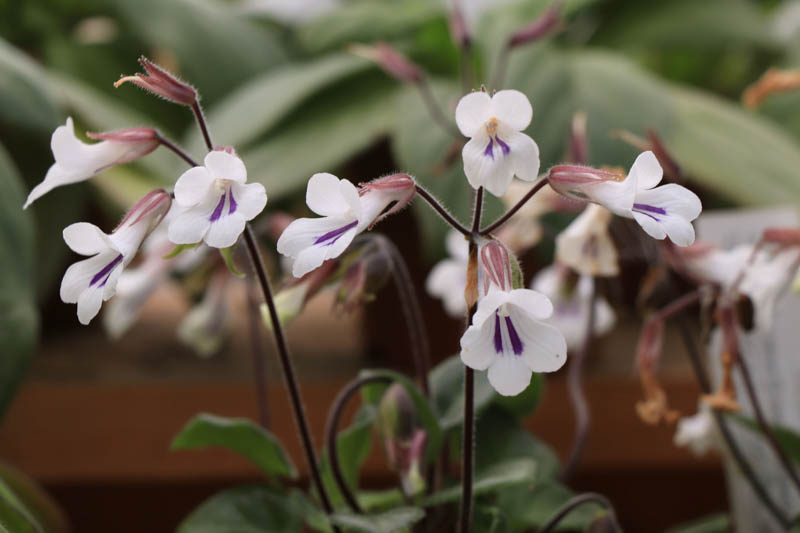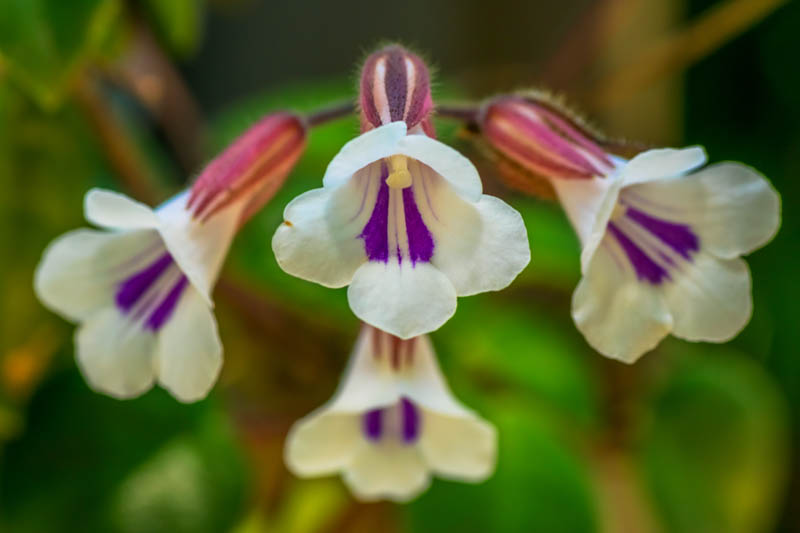Chirita, Asian Violet, Primulina tamiana, Chirita tamiana
Deinostigma tamiana, known as Chirita or Asian Violet, is a charming and lesser-known member of the Gesneriaceae family, prized for its attractive foliage and delicate flowers. This plant is an excellent choice for indoor gardeners looking to diversify their plant collections.
The Asian Violet is noted for its compact, rosette-forming habit and soft, hairy leaves that give it a lush, velvety appearance. Its flowers are trumpet-shaped, typically pale violet with darker purple lines, which add a subtle but striking contrast to its foliage.
Native: This species is native to the mountainous regions of Vietnam, where it thrives in moist, shaded habitats. Its natural environment is characterized by high humidity and moderate temperatures, conditions that are important to mimic for successful cultivation. It belongs to the gesneriad family, Gesneriaceae, which includes Achimenes (Hot Water Plant), Streptocarpus (Cape Primrose), and the popular Sainpaulia (African Violet).
Plant Type and Habit: The Asian Violet a perennial herbaceous plant. It grows as a low, spreading rosette and is typically evergreen, making it a visually appealing plant year-round.
Size: It remains relatively small, typically reaching only about 2-4 inches (5-10 cm) in height and spreading 2-6 inches (5-15 cm). This compact size makes it ideal for windowsills, terrariums, or small hanging baskets.
Flowers: The flowers are its standout feature. They are delicate and trumpet-shaped, typically pale violet with darker purple veins, adding a charming contrast to its lush foliage. They bloom prolifically under the right conditions, appearing in clusters above the foliage. Each bloom lasts for several days, and the flowering period can extend over several months with proper care. The typical bloom time is from late spring through summer, although it can occasionally flower at other times if indoor conditions are favorable.
Foliage: The foliage is soft, green, and covered with fine hairs, giving it a slightly fuzzy texture. The leaves are somewhat rounded with noticeable veining, adding texture and depth to its appearance.
Hardiness: As a tropical plant, the Asian Violet is not frost-tolerant and thrives best in USDA zones 11 and above. It is almost exclusively grown as a houseplant in most regions due to its temperature sensitivity.
Uses: Primarily used as an ornamental indoor plant, it is perfect for adding a touch of the tropics to home décor. Its size and growth habit make it suitable for terrariums, dish gardens, and as a tabletop plant.
Toxicity: Deinostigma tamiana is not known to be toxic to humans or pets, making it a safe choice for a household indoor plant.
Invasiveness: This plant is not considered invasive. It is mainly grown as a controlled indoor plant and does not possess the characteristics typical of invasive species.
Benefits: Growing the Asian Violet can help improve indoor air quality and add to the aesthetic value of home or office spaces. It’s also relatively easy to care for, making it suitable for novice gardeners.

Light: Deinostigma tamiana thrives in bright, indirect light. Place it near a window that receives filtered sunlight, avoiding direct sun exposure which can scorch the leaves. A north or east-facing window is usually ideal.
Soil: Use a well-draining, rich organic potting mix. A mixture commonly used for African violets, consisting of peat moss, perlite, and vermiculite, works well for Deinostigma tamiana.
Watering: Keep the soil consistently moist but not waterlogged. Water the plant when the top inch of soil feels dry. Use room temperature water to avoid shocking the plant’s roots. Ensure adequate drainage to prevent root rot.
Humidity: High humidity levels mimic the plant’s native tropical environment. Maintain humidity around 60-70% if possible. Use a humidifier, or place the plant on a tray filled with pebbles and water to increase moisture around the plant.
Temperature: This plant prefers a warm environment with temperatures ranging from 65°F to 75°F (18°C to 24°C). Avoid placing it in drafts or near heating and cooling vents as sudden temperature fluctuations can stress the plant.
Fertilizing: Feed Deinostigma tamiana every two weeks during the growing season (spring through summer) with a balanced liquid fertilizer diluted to half strength. Reduce feeding in the winter months when plant growth naturally slows.
Pruning: After flowering, prune back the spent flowers to encourage new growth and maintain a compact form. Remove any yellow or dead leaves to keep the plant healthy and attractive.
Repotting: Repot every 1-2 years in the spring, using fresh, well-draining soil. Choose a pot slightly larger than the current one to encourage growth, ensuring it has adequate drainage holes to prevent waterlogging and root rot.
Propagation: Deinostigma tamiana can be easily propagated from leaf cuttings. Simply cut a healthy leaf near the stem, dip the cut end into rooting hormone, and plant it in moist potting mix. Cover with plastic to create a humid environment until roots develop.

The Asian Violet is generally a robust houseplant but can encounter certain pests and diseases, especially when not provided with optimal growing conditions.
Mealybugs: These pests appear as small, white, cottony masses on the plant. Like aphids, they suck sap and weaken the plant, and also excrete honeydew.
Spider mites: These tiny arachnids are barely visible to the naked eye but can cause significant damage. They suck sap from the leaves, leading to stippled, discolored foliage and overall plant stress. Spider mites thrive in dry conditions.
Aphids: Small, soft-bodied insects that cluster on new growth and the undersides of leaves, aphids can weaken the plant by sucking sap and excreting sticky honeydew.
Root rot: Overwatering or poor drainage can lead to root rot, which will manifest as wilting, yellowing leaves and a general decline in plant health.
Powdery mildew: Appears as a white, powdery coating on the leaves, usually due to high humidity combined with poor air circulation.
Leaf Drop: This can occur due to drastic changes in temperature, humidity, or improper watering practices.
Leaf Scorch: Direct sunlight can cause the leaves to scorch and wilt. Provide bright, indirect light instead.
| Hardiness |
11 - 12 |
|---|---|
| Plant Type | Houseplants, Perennials |
| Plant Family | Gesneriaceae |
| Exposure | Partial Sun |
| Season of Interest |
Spring (Early, Mid, Late) Summer (Early, Mid, Late) Fall Winter |
| Height |
2" - 4" (5cm - 10cm) |
| Spread |
2" - 6" (5cm - 15cm) |
| Maintenance | Low |
| Water Needs | Average |
| Soil Type | Loam, Sand |
| Soil pH | Acid, Neutral, Alkaline |
| Soil Drainage | Moist but Well-Drained |
| Characteristics | Showy, Evergreen |
| Garden Uses | Patio And Containers |
| Hardiness |
11 - 12 |
|---|---|
| Plant Type | Houseplants, Perennials |
| Plant Family | Gesneriaceae |
| Exposure | Partial Sun |
| Season of Interest |
Spring (Early, Mid, Late) Summer (Early, Mid, Late) Fall Winter |
| Height |
2" - 4" (5cm - 10cm) |
| Spread |
2" - 6" (5cm - 15cm) |
| Maintenance | Low |
| Water Needs | Average |
| Soil Type | Loam, Sand |
| Soil pH | Acid, Neutral, Alkaline |
| Soil Drainage | Moist but Well-Drained |
| Characteristics | Showy, Evergreen |
| Garden Uses | Patio And Containers |
How many Deinostigma tamiana (Asian Violet) do I need for my garden?
| Plant | Quantity | |
|---|---|---|
| Deinostigma tamiana (Asian Violet) | N/A | Buy Plants |
Create a membership account to save your garden designs and to view them on any device.
Becoming a contributing member of Gardenia is easy and can be done in just a few minutes. If you provide us with your name, email address and the payment of a modest $25 annual membership fee, you will become a full member, enabling you to design and save up to 25 of your garden design ideas.
Join now and start creating your dream garden!
Create a membership account to save your garden designs and to view them on any device.
Becoming a contributing member of Gardenia is easy and can be done in just a few minutes. If you provide us with your name, email address and the payment of a modest $25 annual membership fee, you will become a full member, enabling you to design and save up to 25 of your garden design ideas.
Join now and start creating your dream garden!